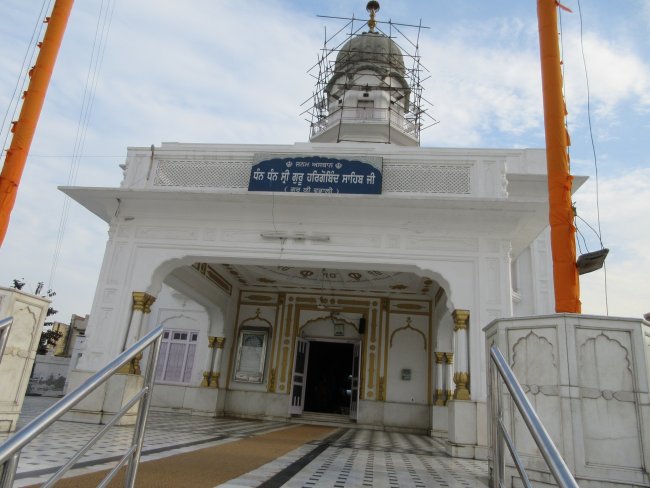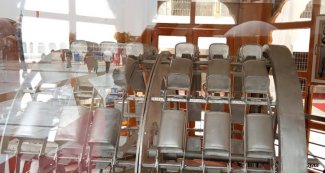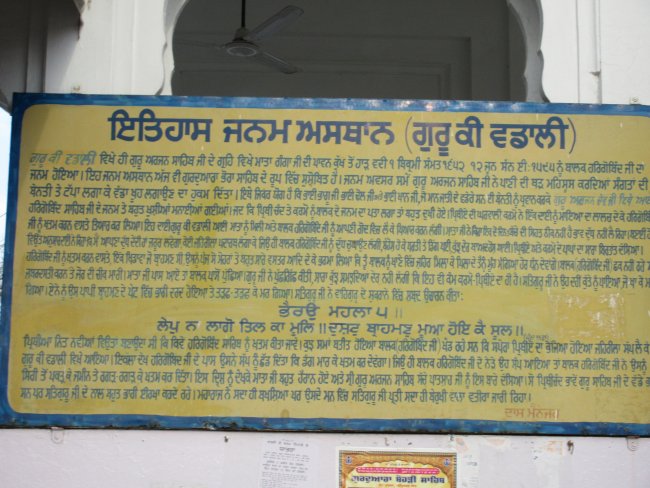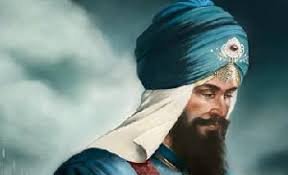The story associated with the birth of Guru Hargobind Sahib Ji is well known. He was born with the blessings of Baba Budha Ji. Mata Ganga Ji, wife of Guru Arjan Dev Ji’s had prepared food with her own hands, carried it over her head to Baba Budha Ji in Wadali on foot. Baba Budha Ji had delightfully accepted the food and blessed her saying; “A son will be born to you, who will crush enemies like I am crushing this onion with my palm.”
Soon Mata Ganga Ji was expecting a child after almost 16 years of her wedding. At the malicious instigation of Prithi Chand, Guru Arjan Dev Ji’s elder brother, Sulhi Khan the Mughal army General was coming to arrest Guru Arjan Dev Ji. So, at the advice of Baba Budha Ji Guru Arjan Dev Ji had moved his family to Wadali. The son, Hargobind Rai was born there (it is also known as Guru Ki Wadali) on 19th June in 1595. During that time, there was severe drought in Punjab and it had deeply affected the people, crops and animals as they were all dying because of scarcity of water and food.
To commemorate the occasion of the child birth, Guru Ji got a well dug in Wadali to alleviate the suffering of masses. The well was so wide and with such abundant supply of water that Guru Ji got six Persian wheels installed there to draw water. Soon the place became known by the unique, distinctive landmark of Chheharta (meaning six Persian wheels). We can see here that even the celebration to commemorate the birth of the child Hargobind becomes an occasion to carry out a philanthropic deed. Guru Ji thanked the Almighty in these words:
ਸਤਿਗੁਰ ਸਾਚੈ ਦੀਆ ਭੇਜਿ ॥ ਚਿਰੁ ਜੀਵਨੁ ਉਪਜਿਆ ਸੰਜੋਗਿ ॥
Satigur saachai dheeaa bhej. Chir jeevan upajiaa sanjog. (SGGS, Pg. No. 396)
Translation: The True Guru has truly given a child. The long-lived one has been born to this destiny.
In the concluding line of the above hymn Guru Ji says that this is not a hidden secret; the child birth is the Almighty’s blessing who has bestowed this gift. However, the special gift was unpalatable to Guru Ji’s elder brother Prithi Chand, as he had his eyes on the Guruship for his son Meharban. So he made numerous attempts on the life of child Hargobind. However, the attempts went futile, finally Guru Arjan Dev Ji asked Mata Ganga Ji to comeback to Amritsar to prevent further attempts on the child’s life. At that time there was smallpox epidemic in Amritsar area and the child Hargobind became its victim. Despite the fact that there was no cure for it, still Hargoind survived and Guru Arjan Dev Ji thanked the Almighty for the providence in these words:
ਸੀਤਲਾ ਠਾਕਿ ਰਹਾਈ ॥ ਬਿਘਨ ਗਏ ਹਰਿ ਨਾਈ ॥1॥ ਮੇਰਾ ਪ੍ਰਭੁ ਹੋਆ ਸਦਾ ਦਇਆਲਾ ॥ ਅਰਦਾਸਿ ਸੁਣੀ ਭਗਤ ਅਪੁਨੇ ਕੀ ਸਭ ਜੀਅ ਭਇਆ ਕਿਰਪਾਲਾ ॥ ਰਹਾਉ ॥
Seetalaa Thaak rahaiee. Bighan ge har naiee. 1. Meraa prabh hoaa sadhaa deeyalaa. Ardaas sunee bhagat apune kee sabh jeea bhiaa kirapaalaa. Rahaau. (SGGS, Pg. No. 627)
Translation: He healed him from the smallpox. My troubles have been removed through the Lord's Name. 1. My God is forever Merciful. He is kind and compassionate to all. He heard the prayer of His devotee. Pause.
As a child Hargobind was instructed in the subjects of spirituality and religion by Bhai Gurdas Ji and the use of arms by Baba Budha Ji. After the cruel execution of Guru Arjan Dev Ji on 30 May 1606, Hargobind was anointed as the successor Guru at a very young age of eleven. The young teenager was now shouldered with the higher responsibilities not just of the family but of the entire community. Even at that young age Guru Hargobind was determined to lift the sagging spirits and infuse a new vigor in them. He gave the inkling of the intention by donning two swords of Miri and Piri, representing spiritual and temporal interests during the anointing ceremony. Still, he never backed away from the spiritual aspects as can be seen from the fact that he forgave Jahangir for the execution of his father Guru Arjan Dev Ji. Bhai Gudas Ji shares that aspect in these words:
ਦਲਿ ਭੰਜਨ ਗੁਰੁ ਸੂਰਮਾ ਵਡ ਜੋਧਾ ਬਹੁ ਪਰਉਪਕਾਰੀ ।
Dal bhanjan gur sooramaa vadd jodhaa bahu paraupakaaree. (Bhai Gurdas Vaar 1.48)
Translation: This Guru, the vanquisher of armies, is very brave and (yet) benevolent.
As passing of the torch was the migration of the soul in the new Guru, it remained unchanged. This was reaffirmed by Bhai Gurdas Ji who stated that the souls of the two Gurus were the same, but the bodies changed in these words:
ਅਰਜਨੁ ਕਾਇਆ ਪਲਟਿ ਕੈ ਮੂਰਤਿ ਹਰਿਗੋਬਿੰਦ ਸਵਾਰੀ।
Arjan kaiaa palaT kai moorat Hargobind savaaree. (Bhai Gurdas Vaar 1.48)
Translation: Arjan (Dev) transformed himself into Harigobind and sat majestically.
Earlier times during the invasion by Babur, Guru Nanak Dev Ji had lashed out at the ebbing patriotism of his people, now Guru Hargobind Ji felt the need to vitalize it with the infusion of new blood. The ruthless persecution of Guru Arjan Dev Ji had convinced the Sikh masses as well that arming in defense was an inevitable necessity for the survival. Guru Hargobind Sahib gave this a concrete shape in by donning two swords, reminding Baba Budha Ji of his prophesy. Additionally Guru Ji initiated construction of Akal Takht in front of Sri Harimander Sahib in 1606 itself, to address spiritual and temporal issues of the Sikhs. The edifice was signaling service, sacrifice, and the defiance of royal authority. The defiance along with establishment of counter center of authority did not sit well with the royalty.
This resulted in stained relations with Emperor Jahangir, who summoned Guru Ji for a face to face meeting. Guru Ji proceeded to Delhi; there he stayed at Majnu- a-Tilla. But he was taken state prisoner and sent to fort of Gwalior in 1617. However, because Jahangir’s ill-health and intervention of Wazir Khan and Mian Mir, Guru Ji was released after the stay lasting 2 years and 3 months in October, 1619. Even in his release Guru Ji provided succor to other 52 royal inmates who secured their release by each holding a tassel of Guru Ji’s custom designed robe, earning him the honorific of “Bandhi Chor Satguru” meaning True Guru Deliverer of Freedom. Later on Jahangir became friendly with Guru Ji. After his death in 1628, his son Shah Jahan succeeded him. On assuming power, Shah Jahan adopted the state policy of antagonism towards non-Muslims. As a result of the policy, the baoli (water tank) in Lahore had been desecrated by filling it up with soil and with a mosque built atop. This ratcheted up the tensions and all that was needed was a slight provocation for a fighting to start. Soon four battles ensued in a quick succession of time as described below:
-
Lohgarh near Amritsar in 1628 - Sikhs were alerted to the upcoming challenges after a royal decree banned preaching of any religion besides Islam. A squad of Sikhs reached near Lahore on a hunting expedition, where they caught the royal hawk. They refused to return the hawk back to royal army soldiers. They in turn made a complaint with Kulij Khan, the Governor of Lahore. He sent an expedition with seven thousand soldiers led by General Mukhlis Khan to attack Amritsar and teach Sikhs a lesson. Guru Ji was busy with preparations for wedding of his daughter Viro, which was just three days away. Despite the distraction from wedding, still Guru Ji had to take this challenge. The Lohgarh fort was attached and the Sikhs fired stones from wooden cannon inflicting heavy toll on the attacking royal forces. Finally, Mukhlis Khan was killed in one-to-one combat with Guru Hargbind Sahib. Mukhlis Khan’s two blows were parried by Guru Ji, and then in one swift blow from Guru Ji’s double edged kirpan, Mukhlis Khan was cut off into two. After the victory, Guru Ji preformed last rites of all the dead and then departed for Jhabal. Next day, the wedding of Bibi Viro was solemnized there. Guru Ji then moved to Kartarpur as a precautionary measure to avoid further hostilities.
-
Hargobindpur in 1630 - Guru Hargobind Sahib came here from Kartarpur in July 1629 and then decided to establish a town on the bank of river Beas. Bhagwan Das Gherar, who was revenue collector there, did not like the idea, so he hired hooligans to intimidate Guru Ji and he himself used abusive language against Guru Ji. This escalated tensions and finally a clash broke out between Gherar’s men and Sikhs, in which Gherar was killed and his body thrown in the river. His son, Rattan Chand wowed vengeance, followed it with a complaint to Governor Abdulla Khan of Jalandhar. Abdulla launched a campaign with 4,000 soldiers and that battle lasted for three days. Both, Abdulla and Rattan Chand were among those slain in the battle, and the remaining Jalandhar army garrison retreated hastily.
-
Nathana (Malwa) in 1631 - Guru Ji had gone on a preaching tour, which was cut short by the tussle with imperial forces over the possession of two of Guru Ji’s prized horses. Bhai Gurbaksh, a Masand from Kabul bought two beautiful horses, and they were being moved when they were seized by the imperial forces from the Sikhs coming from Kabul and sent to royal stable in Lahore fort. When Guru Ji was informed about the forcible extortion; Guru Ji decided to take matter in his hand. He assigned Bhai Bidhi Chand to retrieve the horses-Dil Bagh and Gul Bagh. Bidhi Chand using the disguise of grass-cutter and then that of a fortuneteller restored the horses back to the rightful owner. He had jumped from the high parapet wall of the fort into the flowing river Ravi to escape. Shah Jahan was furious, when he found how the horses had disappeared. He waged a campaign to get the horses back, and Laila Beg volunteered to lead the charge of ten thousand soldiers. He attacked Guru Ji in Nathana, Malwa. In the battle 1,200 Sikhs were killed or wounded and the casualties on the invading side were much higher. The battle began at midnight and lasted for eighteen hours with Guru Ji’s victory. Guru Ji got a tank called Guru Sar built to commemorate the victory there.
-
Kartarpur (Jalandhar area) in 1634 - This time the cause was Painde Khan, who as a orphan child was raised by Guru Ji, but had showed signs of disaffection and was dismissed from the service. He went to Subedar of Jalandhar and induced him to send a strong contingent against Guru Ji. He offered to join them with all the insider information, vowing vengeance against Guru Ji. The fifty thousand men were led by Kale Khan, the brother of Mukhlis Khan, who had died in the first battle. Besides Kale Khan, he was assisted by Qutab Din, Painde Khan, Anwar khan and Usman Khan. The Sikhs were led by Bidhi Chand and Baba Gurditta, the eldest son of Guru Ji. At the end of first day’s battle no side was victorious. Next day, Painde Khan, made an early morning charge at Guru Ji. Painde Khan made three strikes with his sword which were checked by Guru Ji with his shield. Guru Ji then gave him one blow from his Kirpan and he fell from his horse without the blade of his sword and only the handle in his hand. He tried getting under Guru Ji’s horse to topple them both, but Guru Ji struck him on the head with his shield. Guru Ji then dismounted from his horse and asked him to say his last prayer (Kalma) as his time was up. Painde Khan was full of remorse at his ingratitude. Painde Khan replied that his kalma was the Guru Ji’s kirpan. Guru Ji took pity on him and put his shield on his face shading it from the scorching Sun rays while he breathed his last. Then after the death of Kale Khan, Qutub Din the royal army retreated from the battle field.
Guru Ji was never an aggressor, nor did he ever fight for wealth, land, property or for women. The battles were all essentially in self-defense. The success in these battles instilled Sikhs with new found zeal, and self-confidence which was lacking earlier.
During the second battle Guru Ji realized that the battles with rulers will be inevitable so Guru Ji decided to pick a spot and develop a city which will be center of preaching and spreading Sikhism. Guru Ji picked the place and named it Keeratpur. This place had been visited by Guru Nanak Dev Ji during his first journey to the east. Baba Gurditta, the oldest son was assigned the job of developing this city. Guru Hargobind JI retired to Keeratpur and spent last ten years of his life there. He breathed his last on March 03, 1644. Guru Har Rai his grandson succeeded him as the Guru. Guru Sahib developed other cities/places named – Lohgarh, Sri Akal Takht, Dera Sahib Lahore, Keeratpur, Hargobindpur, Mehraj, Kaulsar, Bibeksar, and Gurusar.
His lasting legacies, besides Akal Takht were introduction of Dhaadi Waaran and Gatka – the martial traditions. With these two Guru Ji brought about the magical transformation of the Sikhs to brave, confident, determined, men of steel and a martial race. Thus, he infused new blood in the Sikhs whose spirits were at a low ebb after the cruel execution of Guru Arjan Dev Ji. Still, Guru Hargobind Ji never left his cool even in the midst of battles despite the challenging circumstances. No wonder he is always remembered as the Saint-Soldier.
References:
-
Singh, Roop. Sri Guru Hargobind Sahib Ji; Sakhep Jeewan Jhalkeean (In Punjabi). Dharam Parchar Committee, SGPC, Sri Amritsar
-
Singh, Satbir Principal. Guru Hargobind Sahib Ji; Sachitaar Jeewani (In Punjabi). Dharam Parchar Committee, SGPC, Sri Amritsar
-
Singh Teja and Singh Ganda. A Short History of the Sikhs; Vol. 1. Publications Bureau, Punjabi University, Patiala
-
Singh Kartar and Dhillon, Gurdial Singh. Stories from Sikh History; Book III. Hemkunt Press, New Delhi 110028
-
Sikh Religion. By Sikh Missionary Society, Detroit, Michigan
-
Jagdev, Santokh Singh. Bed Times Stories – 6. Sikh Missionary Resource Centre, Birmingham, England









